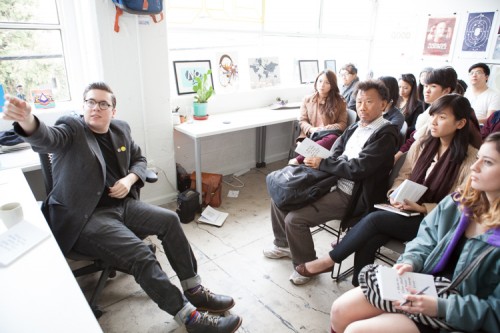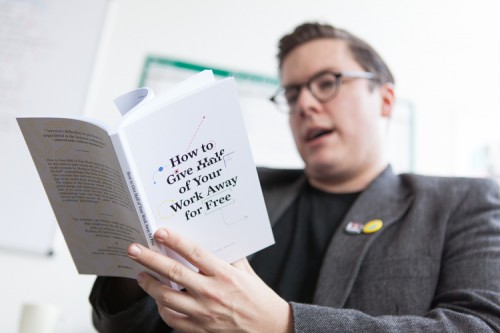
Art Center students visit alum Matthew Manos’ verynice design studio in Venice. (Photo by Stella Kalinina)
Professionally speaking, alumnus Matthew Manos (MFA 12) was precocious. At age 19 in 2008 he founded his own design studio, verynice, a service free to nonprofits using design as a tool for problem solving. By 2012, with a full-time staff of two, verynice was providing $300,000 in pro bono services.
Today, with offices in Los Angeles and New York and a staff of 10 and growing, Manos’ innovative studio has donated the equivalent of more than a million dollars in services to some 250 nonprofit organizations with the help of skills-based volunteers around the globe. Manos’ book, How to Give Half of Your Work Away for Free, open-sources his 50% pro-bono business model. His givehalf.co platform is inspiring other companies to do the same.
And, while doing good can be its own reward, verynice is reaping a more tangible benefit: The company’s growing list of prestigious paying clients includes NASA, Facebook, MTV, Disney Imagineering and Kaiser Permanente, among many others.
Art Center’s graduate program in Media Design Practices, says Manos, helped verynice evolve from its informal roots—he launched the enterprise while a UCLA undergrad—into what it is today: a “global design, business, and innovation consultancy specializing in solutions for social and cultural impact.”
He enrolled in the program’s Lab Field Track in 2010, attracted by a description he read. “They were saying that they wanted to prepare designers for jobs that don’t exist yet,” Manos recalls. “That was something that really excited me.”
One of the biggest lessons he learned at Art Center, “is that it’s very much the invisible things, as much as the visible things, that are being designed. I had just sort of assumed that design was limited to things that you can see on paper or on the web—very visual things.” It was a “major revelation,” Manos says, to discover that design could impact “experiences, or emotions, or feelings, systems and ideas.”
Another revelation: something he was “sort of dabbling in, but never knew that it was a thing—that you can create your own category of design and that’s OK.”
Art Center was responsible, too, for a significant change to verynice in 2012, the year that Manos graduated. He brought on a partner, multidisciplinary designer Bora Shin (MFA 12), whom he had met in the Media Design program. The move refreshed his passion for the work, Manos said. “I felt like it wasn’t just me leading this thing anymore.”
Manos describes his creative practice today as “very much all over the place. What I’m most interested in is business models, but not in the sense of ‘let’s make this business successful’ or anything like that,” he says. “More, how can we create ideas and impacts that are actually sustainable and scalable?
“I’ve found that it’s easy to come up with an idea for some cool product that brings water to an indigenous area or something like that, but it’s really hard to then take that idea and have it last 10 years without you doing anything else.” That’s at the core of his practice as a designer, Manos says. “I’m trying to think that if I’m coming up with an idea for myself or for a client, how can this outlive me? That is always my goal.
“When I started this company, I saw it sort of as a side project, or a hobby,” he adds. “I really liked working with nonprofits and I just figured, well, a good way to attract a lot of them and help them out is to not charge them.” From a business perspective, however, Manos found that nonprofits are well-connected. Volunteer staff at smaller nonprofits “have jobs elsewhere, so that becomes referrals for us. The larger nonprofits we work with, their boards of directors tend to be high-level executives at big companies.
“I think some of our projects with Disney,” he says, “were a direct result of a recommendation from a board member of a nonprofit. Those are things that we feel like we never would have been able to do if not for that kind of connection.”

Matthew Manos with his book that’s inspiring others to give away half their work.
Of all his achievements to date, what pleases Manos the most is seeing others replicate his business model.
“I never thought this would turn into a quote, unquote movement of some sort,” he says. “I think the first day that somebody emailed me and said, ‘hey, I wanted to let you know that I’m giving away half our work for free, inspired by you guys,’ that just was mind-blowing. And now there’s probably five or six companies that are running it, going strong, and several dozen that I’m basically mentoring and serving as an advisor to help get them there. That’s exciting.”
–
Lynne Heffley is a Los Angeles-based freelance journalist who writes about the arts.








